| Listing 1 - 10 of 17 | << page >> |
Sort by
|
Book
ISBN: 1400882001 Year: 2016 Publisher: Princeton, NJ : Princeton University Press,
Abstract | Keywords | Export | Availability | Bookmark
 Loading...
Loading...Choose an application
- Reference Manager
- EndNote
- RefWorks (Direct export to RefWorks)
This book serves both as a completely self-contained introduction and as an exposition of new results in the field of recursive function theory and its application to formal systems.
Recursive functions. --- Metamathematics. --- Addition. --- Algebraic geometry. --- Alonzo Church. --- Arithmetic function. --- Arithmetic. --- Atomic sentence. --- Axiom A. --- Axiom schema. --- Axiom. --- Axiomatic system. --- Binary relation. --- Cantor's diagonal argument. --- Cartesian product. --- Characterization (mathematics). --- Chinese remainder theorem. --- Closed-form expression. --- Closure (mathematics). --- Combination. --- Combinatory logic. --- Complement (set theory). --- Concatenation theory. --- Consistency. --- Constructive proof. --- Corollary. --- Countable set. --- Counterexample. --- Decidability (logic). --- Decision problem. --- Definable set. --- Diagonalization. --- Direct proof. --- Disjoint sets. --- Enumeration. --- Equation. --- Existential quantification. --- Exponential function. --- Finite set. --- Formal system. --- Functional calculus. --- Gödel numbering. --- Gödel's incompleteness theorems. --- Herbrand's theorem. --- Inference. --- Integer factorization. --- Iteration. --- John Myhill. --- Logical connective. --- Logical consequence. --- Mathematical induction. --- Mathematical logic. --- Mathematician. --- Mathematics. --- Modus ponens. --- Natural number. --- Negation. --- Number theory. --- Order theory. --- Parity (mathematics). --- Peano axioms. --- Predicate (mathematical logic). --- Prenex normal form. --- Primitive recursive function. --- Quantifier (logic). --- Recursion. --- Recursive set. --- Recursively enumerable set. --- Remainder. --- Requirement. --- Rule of inference. --- Scientific notation. --- Sequence. --- Set (mathematics). --- Sign (mathematics). --- Special case. --- Subset. --- Suggestion. --- System U. --- Theorem. --- Theory. --- Transfinite number. --- Turing machine. --- Universal set. --- Validity. --- Variable (mathematics). --- Zermelo set theory.
Book
ISBN: 140088232X Year: 2016 Publisher: Princeton, NJ : Princeton University Press,
Abstract | Keywords | Export | Availability | Bookmark
 Loading...
Loading...Choose an application
- Reference Manager
- EndNote
- RefWorks (Direct export to RefWorks)
The description for this book, Surface Area. (AM-35), Volume 35, will be forthcoming.
Surfaces. --- Absolute continuity. --- Addition. --- Admissible set. --- Arc length. --- Axiom. --- Axiomatic system. --- Bearing (navigation). --- Bounded variation. --- Calculus of variations. --- Circumference. --- Compact space. --- Complex analysis. --- Concentric. --- Connected space. --- Continuous function (set theory). --- Continuous function. --- Corollary. --- Countable set. --- Covering set. --- Curve. --- Derivative. --- Diameter. --- Differentiable function. --- Differential geometry. --- Direct proof. --- Dirichlet integral. --- Disjoint sets. --- Empty set. --- Equation. --- Equicontinuity. --- Existence theorem. --- Existential quantification. --- Function (mathematics). --- Functional analysis. --- Geometry. --- Hausdorff measure. --- Homeomorphism. --- Homotopy. --- Infimum and supremum. --- Integral geometry. --- Intersection number (graph theory). --- Interval (mathematics). --- Iterative method. --- Jacobian. --- Lebesgue integration. --- Lebesgue measure. --- Limit (mathematics). --- Limit point. --- Limit superior and limit inferior. --- Linearity. --- Line–line intersection. --- Locally compact space. --- Mathematician. --- Mathematics. --- Measure (mathematics). --- Metric space. --- Morphism. --- Natural number. --- Nonparametric statistics. --- Orientability. --- Parameter. --- Parametric equation. --- Parametric surface. --- Partial derivative. --- Potential theory. --- Radon–Nikodym theorem. --- Representation theorem. --- Representation theory. --- Right angle. --- Semi-continuity. --- Set function. --- Set theory. --- Sign (mathematics). --- Smoothness. --- Space-filling curve. --- Subset. --- Summation. --- Surface area. --- Tangent space. --- Theorem. --- Topological space. --- Topology. --- Total order. --- Total variation. --- Uniform convergence. --- Unit square.
Book
ISBN: 1400882656 Year: 2016 Publisher: Princeton, NJ : Princeton University Press,
Abstract | Keywords | Export | Availability | Bookmark
 Loading...
Loading...Choose an application
- Reference Manager
- EndNote
- RefWorks (Direct export to RefWorks)
The description for this book, Elementary Differential Topology. (AM-54), Volume 54, will be forthcoming.
Differential topology. --- Addition. --- Affine transformation. --- Algebraic topology. --- Analytic manifold. --- Approximation. --- Barycentric coordinate system. --- Barycentric subdivision. --- Basis (linear algebra). --- Brouwer fixed-point theorem. --- CR manifold. --- Centroid. --- Chain rule. --- Closed set. --- Combinatorics. --- Compact space. --- Conjecture. --- Continuous function. --- Convex set. --- Coordinate system. --- Corollary. --- Degeneracy (mathematics). --- Diameter. --- Diffeomorphism. --- Differentiable function. --- Differentiable manifold. --- Dimension (vector space). --- Dimension theory (algebra). --- Dimension theory. --- Disjoint sets. --- Elementary proof. --- Empty set. --- Equation. --- Euclidean space. --- Existential quantification. --- Function composition. --- Fundamental theorem. --- General topology. --- Geometry. --- Grassmannian. --- Homeomorphism. --- Homotopy. --- Hyperplane. --- Identity matrix. --- Inclusion map. --- Integer. --- Intersection (set theory). --- Invariance of domain. --- Jacobian matrix and determinant. --- Line segment. --- Linear algebra. --- Linear equation. --- Linear map. --- Locally compact space. --- Manifold. --- Mathematical induction. --- Matrix multiplication. --- Metrization theorem. --- Natural number. --- Number theory. --- Open set. --- Partial derivative. --- Partition of unity. --- Polyhedron. --- Polytope. --- Regular homotopy. --- Remainder. --- Scientific notation. --- Secant. --- Similarity (geometry). --- Simplex. --- Simplicial complex. --- Smoothness. --- Special case. --- Submanifold. --- Subset. --- Tangent bundle. --- Tangent vector. --- Theorem. --- Thickness (graph theory). --- Topological manifold. --- Topology. --- Trigonometric functions. --- Unit cube. --- Word problem (mathematics).
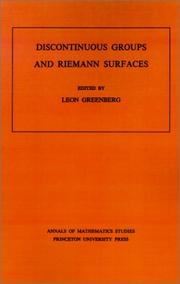
ISBN: 0691081387 1400881641 9780691081380 Year: 2016 Volume: 79 Publisher: Princeton, NJ : Princeton University Press,
Abstract | Keywords | Export | Availability | Bookmark
 Loading...
Loading...Choose an application
- Reference Manager
- EndNote
- RefWorks (Direct export to RefWorks)
Study 79 contains a collection of papers presented at the Conference on Discontinuous Groups and Ricmann Surfaces at the University of Maryland, May 21-25, 1973. The papers, by leading authorities, deal mainly with Fuchsian and Kleinian groups, Teichmüller spaces, Jacobian varieties, and quasiconformal mappings. These topics are intertwined, representing a common meeting of algebra, geometry, and analysis.
Group theory --- Complex analysis --- Number theory --- RIEMANN SURFACES --- Discontinuous groups --- congresses --- Congresses --- Riemann surfaces --- Congresses. --- Groupes discontinus --- Combinatorial topology --- Functions of complex variables --- Surfaces, Riemann --- Functions --- Abelian variety. --- Adjunction (field theory). --- Affine space. --- Algebraic curve. --- Algebraic structure. --- Analytic function. --- Arithmetic genus. --- Automorphism. --- Bernhard Riemann. --- Boundary (topology). --- Cauchy sequence. --- Cauchy–Schwarz inequality. --- Cayley–Hamilton theorem. --- Closed geodesic. --- Combination. --- Commutative diagram. --- Commutator subgroup. --- Compact Riemann surface. --- Complex dimension. --- Complex manifold. --- Complex multiplication. --- Complex space. --- Complex torus. --- Congruence subgroup. --- Conjugacy class. --- Convex set. --- Cyclic group. --- Degeneracy (mathematics). --- Diagram (category theory). --- Diffeomorphism. --- Differential form. --- Dimension (vector space). --- Disjoint sets. --- E7 (mathematics). --- Endomorphism. --- Equation. --- Equivalence class. --- Euclidean space. --- Existence theorem. --- Existential quantification. --- Finite group. --- Finitely generated group. --- Fuchsian group. --- Fundamental domain. --- Fundamental lemma (Langlands program). --- Fundamental polygon. --- Galois extension. --- Holomorphic function. --- Homeomorphism. --- Homology (mathematics). --- Homomorphism. --- Hurwitz's theorem (number theory). --- Inclusion map. --- Inequality (mathematics). --- Inner automorphism. --- Intersection (set theory). --- Irreducibility (mathematics). --- Isomorphism class. --- Isomorphism theorem. --- Jacobian variety. --- Jordan curve theorem. --- Kleinian group. --- Limit point. --- Mapping class group. --- Metric space. --- Monodromy. --- Monomorphism. --- Möbius transformation. --- Non-Euclidean geometry. --- Orthogonal trajectory. --- Permutation. --- Polynomial. --- Power series. --- Projective variety. --- Quadratic differential. --- Quadric. --- Quasi-projective variety. --- Quasiconformal mapping. --- Quotient space (topology). --- Rectangle. --- Riemann mapping theorem. --- Riemann surface. --- Schwarzian derivative. --- Simply connected space. --- Simultaneous equations. --- Special case. --- Subgroup. --- Subsequence. --- Surjective function. --- Symmetric space. --- Tangent space. --- Teichmüller space. --- Theorem. --- Topological space. --- Topology. --- Uniqueness theorem. --- Unit disk. --- Variable (mathematics). --- Winding number. --- Word problem (mathematics). --- RIEMANN SURFACES - congresses --- Discontinuous groups - Congresses --- Geometrie algebrique --- Fonctions d'une variable complexe --- Surfaces de riemann
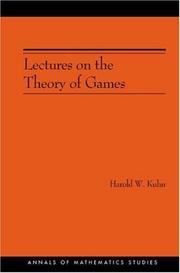
ISBN: 0691027714 0691027722 9786612159114 1282159119 1400829569 9781400829569 9781282159112 6612159111 9780691027715 9780691027722 Year: 2003 Volume: 37 Publisher: Princeton, N.J. Princeton University Press
Abstract | Keywords | Export | Availability | Bookmark
 Loading...
Loading...Choose an application
- Reference Manager
- EndNote
- RefWorks (Direct export to RefWorks)
This book is a spectacular introduction to the modern mathematical discipline known as the Theory of Games. Harold Kuhn first presented these lectures at Princeton University in 1952. They succinctly convey the essence of the theory, in part through the prism of the most exciting developments at its frontiers half a century ago. Kuhn devotes considerable space to topics that, while not strictly the subject matter of game theory, are firmly bound to it. These are taken mainly from the geometry of convex sets and the theory of probability distributions. The book opens by addressing "matrix games," a name first introduced in these lectures as an abbreviation for two-person, zero-sum games in normal form with a finite number of pure strategies. It continues with a treatment of games in extensive form, using a model introduced by the author in 1950 that quickly supplanted von Neumann and Morgenstern's cumbersome approach. A final section deals with games that have an infinite number of pure strategies for the two players. Throughout, the theory is generously illustrated with examples, and exercises test the reader's understanding. A historical note caps off each chapter. For readers familiar with the calculus and with elementary matrix theory or vector analysis, this book offers an indispensable store of vital insights on a subject whose importance has only grown with the years.
Operational research. Game theory --- Game theory --- 519.83 --- Theory of games --- 519.83 Theory of games --- Game theory. --- Games, Theory of --- Mathematical models --- Mathematics --- Abstract algebra. --- Addition. --- Algorithm. --- Almost surely. --- Analytic geometry. --- Axiom. --- Basic solution (linear programming). --- Big O notation. --- Bijection. --- Binary relation. --- Boundary (topology). --- Bounded set (topological vector space). --- Branch point. --- Calculation. --- Cardinality of the continuum. --- Cardinality. --- Cartesian coordinate system. --- Characteristic function (probability theory). --- Combination. --- Computation. --- Connectivity (graph theory). --- Constructive proof. --- Convex combination. --- Convex function. --- Convex hull. --- Convex set. --- Coordinate system. --- David Gale. --- Diagram (category theory). --- Differential equation. --- Dimension (vector space). --- Dimensional analysis. --- Disjoint sets. --- Distribution function. --- Embedding. --- Empty set. --- Enumeration. --- Equation. --- Equilibrium point. --- Equivalence relation. --- Estimation. --- Euclidean space. --- Existential quantification. --- Expected loss. --- Extreme point. --- Formal scheme. --- Fundamental theorem. --- Galois theory. --- Geometry. --- Hyperplane. --- Inequality (mathematics). --- Infimum and supremum. --- Integer. --- Iterative method. --- Line segment. --- Linear equation. --- Linear inequality. --- Matching Pennies. --- Mathematical induction. --- Mathematical optimization. --- Mathematical theory. --- Mathematician. --- Mathematics. --- Matrix (mathematics). --- Measure (mathematics). --- Min-max theorem. --- Minimum distance. --- Mutual exclusivity. --- Prediction. --- Probability distribution. --- Probability interpretations. --- Probability measure. --- Probability theory. --- Probability. --- Proof by contradiction. --- Quantity. --- Rank (linear algebra). --- Rational number. --- Real number. --- Requirement. --- Scientific notation. --- Sign (mathematics). --- Solution set. --- Special case. --- Statistics. --- Strategist. --- Strategy (game theory). --- Subset. --- Theorem. --- Theory of Games and Economic Behavior. --- Theory. --- Three-dimensional space (mathematics). --- Total order. --- Two-dimensional space. --- Union (set theory). --- Unit interval. --- Unit square. --- Vector Analysis. --- Vector calculus. --- Vector space.
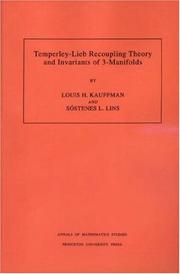
ISBN: 0691036411 0691036403 1400882532 9780691036403 9780691036410 Year: 2016 Volume: 134 Publisher: Princeton, NJ : Princeton University Press,
Abstract | Keywords | Export | Availability | Bookmark
 Loading...
Loading...Choose an application
- Reference Manager
- EndNote
- RefWorks (Direct export to RefWorks)
This book offers a self-contained account of the 3-manifold invariants arising from the original Jones polynomial. These are the Witten-Reshetikhin-Turaev and the Turaev-Viro invariants. Starting from the Kauffman bracket model for the Jones polynomial and the diagrammatic Temperley-Lieb algebra, higher-order polynomial invariants of links are constructed and combined to form the 3-manifold invariants. The methods in this book are based on a recoupling theory for the Temperley-Lieb algebra. This recoupling theory is a q-deformation of the SU(2) spin networks of Roger Penrose. The recoupling theory is developed in a purely combinatorial and elementary manner. Calculations are based on a reformulation of the Kirillov-Reshetikhin shadow world, leading to expressions for all the invariants in terms of state summations on 2-cell complexes. Extensive tables of the invariants are included. Manifolds in these tables are recognized by surgery presentations and by means of 3-gems (graph encoded 3-manifolds) in an approach pioneered by Sostenes Lins. The appendices include information about gems, examples of distinct manifolds with the same invariants, and applications to the Turaev-Viro invariant and to the Crane-Yetter invariant of 4-manifolds.
Drie-menigvuldigheden (Topologie) --- Knopentheorie --- Knot theory --- Noeuds [Theorie des ] --- Three-manifolds (Topology) --- Trois-variétés (Topologie) --- Knot theory. --- Algebraic topology --- Invariants --- Mathematics --- Invariants (Mathematics) --- Invariants. --- 3-manifolds (Topology) --- Manifolds, Three dimensional (Topology) --- Three-dimensional manifolds (Topology) --- Low-dimensional topology --- Topological manifolds --- Knots (Topology) --- 3-manifold. --- Addition. --- Algorithm. --- Ambient isotopy. --- Axiom. --- Backslash. --- Barycentric subdivision. --- Bijection. --- Bipartite graph. --- Borromean rings. --- Boundary parallel. --- Bracket polynomial. --- Calculation. --- Canonical form. --- Cartesian product. --- Cobordism. --- Coefficient. --- Combination. --- Commutator. --- Complex conjugate. --- Computation. --- Connected component (graph theory). --- Connected sum. --- Cubic graph. --- Diagram (category theory). --- Dimension. --- Disjoint sets. --- Disjoint union. --- Elaboration. --- Embedding. --- Equation. --- Equivalence class. --- Explicit formula. --- Explicit formulae (L-function). --- Factorial. --- Fundamental group. --- Graph (discrete mathematics). --- Graph embedding. --- Handlebody. --- Homeomorphism. --- Homology (mathematics). --- Identity element. --- Intersection form (4-manifold). --- Inverse function. --- Jones polynomial. --- Kirby calculus. --- Line segment. --- Linear independence. --- Matching (graph theory). --- Mathematical physics. --- Mathematical proof. --- Mathematics. --- Maxima and minima. --- Monograph. --- Natural number. --- Network theory. --- Notation. --- Numerical analysis. --- Orientability. --- Orthogonality. --- Pairing. --- Pairwise. --- Parametrization. --- Parity (mathematics). --- Partition function (mathematics). --- Permutation. --- Poincaré conjecture. --- Polyhedron. --- Quantum group. --- Quantum invariant. --- Recoupling. --- Recursion. --- Reidemeister move. --- Result. --- Roger Penrose. --- Root of unity. --- Scientific notation. --- Sequence. --- Significant figures. --- Simultaneous equations. --- Smoothing. --- Special case. --- Sphere. --- Spin network. --- Summation. --- Symmetric group. --- Tetrahedron. --- The Geometry Center. --- Theorem. --- Theory. --- Three-dimensional space (mathematics). --- Time complexity. --- Tubular neighborhood. --- Two-dimensional space. --- Vector field. --- Vector space. --- Vertex (graph theory). --- Winding number. --- Writhe.
Book
ISBN: 0691079994 1400881986 9780691079998 Year: 2016 Volume: 38 Publisher: Princeton, NJ : Princeton University Press,
Abstract | Keywords | Export | Availability | Bookmark
 Loading...
Loading...Choose an application
- Reference Manager
- EndNote
- RefWorks (Direct export to RefWorks)
The description for this book, Linear Inequalities and Related Systems. (AM-38), Volume 38, will be forthcoming.
Operational research. Game theory --- Linear programming. --- Matrices. --- Game theory. --- Games, Theory of --- Theory of games --- Mathematical models --- Mathematics --- Algebra, Matrix --- Cracovians (Mathematics) --- Matrix algebra --- Matrixes (Algebra) --- Algebra, Abstract --- Algebra, Universal --- Production scheduling --- Programming (Mathematics) --- Banach space. --- Basic solution (linear programming). --- Big O notation. --- Bilinear form. --- Boundary (topology). --- Brouwer fixed-point theorem. --- Characterization (mathematics). --- Coefficient. --- Combination. --- Computation. --- Computational problem. --- Convex combination. --- Convex cone. --- Convex hull. --- Convex set. --- Corollary. --- Correlation and dependence. --- Cramer's rule. --- Cyclic permutation. --- Dedekind cut. --- Degeneracy (mathematics). --- Determinant. --- Diagram (category theory). --- Dilworth's theorem. --- Dimension (vector space). --- Directional derivative. --- Disjoint sets. --- Doubly stochastic matrix. --- Dual space. --- Duality (mathematics). --- Duality (optimization). --- Eigenvalues and eigenvectors. --- Elementary proof. --- Equation solving. --- Equation. --- Equivalence class. --- Euclidean space. --- Existence theorem. --- Existential quantification. --- Extreme point. --- Fixed-point theorem. --- Functional analysis. --- Fundamental theorem. --- General equilibrium theory. --- Hall's theorem. --- Hilbert space. --- Incidence matrix. --- Inequality (mathematics). --- Infimum and supremum. --- Invertible matrix. --- Kakutani fixed-point theorem. --- Lagrange multiplier. --- Linear equation. --- Linear inequality. --- Linear map. --- Linear space (geometry). --- Linear subspace. --- Loss function. --- Main diagonal. --- Mathematical induction. --- Mathematical optimization. --- Mathematical problem. --- Max-flow min-cut theorem. --- Maxima and minima. --- Maximal set. --- Maximum flow problem. --- Menger's theorem. --- Minor (linear algebra). --- Monotonic function. --- N-vector. --- Nonlinear programming. --- Nonnegative matrix. --- Parity (mathematics). --- Partially ordered set. --- Permutation matrix. --- Permutation. --- Polyhedron. --- Quantity. --- Representation theorem. --- Row and column vectors. --- Scientific notation. --- Sensitivity analysis. --- Set notation. --- Sign (mathematics). --- Simplex algorithm. --- Simultaneous equations. --- Solution set. --- Special case. --- Subset. --- Summation. --- System of linear equations. --- Theorem. --- Transpose. --- Unit sphere. --- Unit vector. --- Upper and lower bounds. --- Variable (mathematics). --- Vector space. --- Von Neumann's theorem.
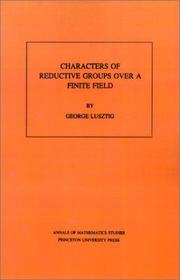
ISBN: 0691083509 0691083517 1400881773 9780691083513 9780691083506 Year: 2016 Volume: 107 Publisher: Princeton, NJ : Princeton University Press,
Abstract | Keywords | Export | Availability | Bookmark
 Loading...
Loading...Choose an application
- Reference Manager
- EndNote
- RefWorks (Direct export to RefWorks)
This book presents a classification of all (complex)irreducible representations of a reductive group withconnected centre, over a finite field. To achieve this,the author uses etale intersection cohomology, anddetailed information on representations of Weylgroups.
512 --- Characters of groups --- Finite fields (Algebra) --- Finite groups --- Groups, Finite --- Group theory --- Modules (Algebra) --- Modular fields (Algebra) --- Algebra, Abstract --- Algebraic fields --- Galois theory --- Characters, Group --- Group characters --- Groups, Characters of --- Representations of groups --- Rings (Algebra) --- Algebra --- 512 Algebra --- Finite groups. --- Characters of groups. --- Addition. --- Algebra representation. --- Algebraic closure. --- Algebraic group. --- Algebraic variety. --- Algebraically closed field. --- Bijection. --- Borel subgroup. --- Cartan subalgebra. --- Character table. --- Character theory. --- Characteristic function (probability theory). --- Characteristic polynomial. --- Class function (algebra). --- Classical group. --- Coefficient. --- Cohomology with compact support. --- Cohomology. --- Combination. --- Complex number. --- Computation. --- Conjugacy class. --- Connected component (graph theory). --- Coxeter group. --- Cyclic group. --- Cyclotomic polynomial. --- David Kazhdan. --- Dense set. --- Derived category. --- Diagram (category theory). --- Dimension. --- Direct sum. --- Disjoint sets. --- Disjoint union. --- E6 (mathematics). --- Eigenvalues and eigenvectors. --- Endomorphism. --- Equivalence class. --- Equivalence relation. --- Existential quantification. --- Explicit formula. --- Explicit formulae (L-function). --- Fiber bundle. --- Finite field. --- Finite group. --- Fourier transform. --- Green's function. --- Group (mathematics). --- Group action. --- Group representation. --- Harish-Chandra. --- Hecke algebra. --- Identity element. --- Integer. --- Irreducible representation. --- Isomorphism class. --- Jordan decomposition. --- Line bundle. --- Linear combination. --- Local system. --- Mathematical induction. --- Maximal torus. --- Module (mathematics). --- Monodromy. --- Morphism. --- Orthonormal basis. --- P-adic number. --- Parametrization. --- Parity (mathematics). --- Partially ordered set. --- Perverse sheaf. --- Pointwise. --- Polynomial. --- Quantity. --- Rational point. --- Reductive group. --- Ree group. --- Schubert variety. --- Scientific notation. --- Semisimple Lie algebra. --- Sheaf (mathematics). --- Simple group. --- Simple module. --- Special case. --- Standard basis. --- Subset. --- Subtraction. --- Summation. --- Surjective function. --- Symmetric group. --- Tensor product. --- Theorem. --- Two-dimensional space. --- Unipotent representation. --- Vector bundle. --- Vector space. --- Verma module. --- Weil conjecture. --- Weyl group. --- Zariski topology.
Book
ISBN: 0691145423 0691145415 9780691145419 9780691145426 1282645064 9786612645068 1400835402 9781400835409 Year: 2010 Publisher: Princeton Princeton University Press
Abstract | Keywords | Export | Availability | Bookmark
 Loading...
Loading...Choose an application
- Reference Manager
- EndNote
- RefWorks (Direct export to RefWorks)
Ramsey theory is a fast-growing area of combinatorics with deep connections to other fields of mathematics such as topological dynamics, ergodic theory, mathematical logic, and algebra. The area of Ramsey theory dealing with Ramsey-type phenomena in higher dimensions is particularly useful. Introduction to Ramsey Spaces presents in a systematic way a method for building higher-dimensional Ramsey spaces from basic one-dimensional principles. It is the first book-length treatment of this area of Ramsey theory, and emphasizes applications for related and surrounding fields of mathematics, such as set theory, combinatorics, real and functional analysis, and topology. In order to facilitate accessibility, the book gives the method in its axiomatic form with examples that cover many important parts of Ramsey theory both finite and infinite. An exciting new direction for combinatorics, this book will interest graduate students and researchers working in mathematical subdisciplines requiring the mastery and practice of high-dimensional Ramsey theory.
Algebraic spaces. --- Ramsey theory. --- Ramsey theory --- Algebraic spaces --- Mathematics --- Algebra --- Physical Sciences & Mathematics --- Spaces, Algebraic --- Geometry, Algebraic --- Combinatorial analysis --- Graph theory --- Analytic set. --- Axiom of choice. --- Baire category theorem. --- Baire space. --- Banach space. --- Bijection. --- Binary relation. --- Boolean prime ideal theorem. --- Borel equivalence relation. --- Borel measure. --- Borel set. --- C0. --- Cantor cube. --- Cantor set. --- Cantor space. --- Cardinality. --- Characteristic function (probability theory). --- Characterization (mathematics). --- Combinatorics. --- Compact space. --- Compactification (mathematics). --- Complete metric space. --- Completely metrizable space. --- Constructible universe. --- Continuous function (set theory). --- Continuous function. --- Corollary. --- Countable set. --- Counterexample. --- Decision problem. --- Dense set. --- Diagonalization. --- Dimension (vector space). --- Dimension. --- Discrete space. --- Disjoint sets. --- Dual space. --- Embedding. --- Equation. --- Equivalence relation. --- Existential quantification. --- Family of sets. --- Forcing (mathematics). --- Forcing (recursion theory). --- Gap theorem. --- Geometry. --- Ideal (ring theory). --- Infinite product. --- Lebesgue measure. --- Limit point. --- Lipschitz continuity. --- Mathematical induction. --- Mathematical problem. --- Mathematics. --- Metric space. --- Metrization theorem. --- Monotonic function. --- Natural number. --- Natural topology. --- Neighbourhood (mathematics). --- Null set. --- Open set. --- Order type. --- Partial function. --- Partially ordered set. --- Peano axioms. --- Point at infinity. --- Pointwise. --- Polish space. --- Probability measure. --- Product measure. --- Product topology. --- Property of Baire. --- Ramsey's theorem. --- Right inverse. --- Scalar multiplication. --- Schauder basis. --- Semigroup. --- Sequence. --- Sequential space. --- Set (mathematics). --- Set theory. --- Sperner family. --- Subsequence. --- Subset. --- Subspace topology. --- Support function. --- Symmetric difference. --- Theorem. --- Topological dynamics. --- Topological group. --- Topological space. --- Topology. --- Tree (data structure). --- Unit interval. --- Unit sphere. --- Variable (mathematics). --- Well-order. --- Zorn's lemma.
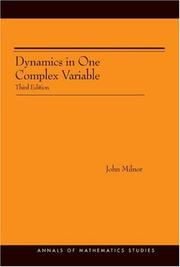
ISBN: 9780691124889 9780691124872 0691124884 0691124876 9786613001481 1400835534 1283001489 9781400835539 9781283001489 6613001481 Year: 2006 Publisher: Princeton Princeton University Press
Abstract | Keywords | Export | Availability | Bookmark
 Loading...
Loading...Choose an application
- Reference Manager
- EndNote
- RefWorks (Direct export to RefWorks)
This volume studies the dynamics of iterated holomorphic mappings from a Riemann surface to itself, concentrating on the classical case of rational maps of the Riemann sphere. This subject is large and rapidly growing. These lectures are intended to introduce some key ideas in the field, and to form a basis for further study. The reader is assumed to be familiar with the rudiments of complex variable theory and of two-dimensional differential geometry, as well as some basic topics from topology. This third edition contains a number of minor additions and improvements: A historical survey has been added, the definition of Lattés map has been made more inclusive, and the écalle-Voronin theory of parabolic points is described. The résidu itératif is studied, and the material on two complex variables has been expanded. Recent results on effective computability have been added, and the references have been expanded and updated. Written in his usual brilliant style, the author makes difficult mathematics look easy. This book is a very accessible source for much of what has been accomplished in the field.
Functions of complex variables --- Holomorphic mappings --- Riemann surfaces --- Fonctions d'une variable complexe --- Applications holomorphes --- Riemann, surfaces de --- Holomorphic mappings. --- Mappings, Holomorphic --- Functions of complex variables. --- Riemann surfaces. --- Surfaces, Riemann --- Functions --- Functions of several complex variables --- Mappings (Mathematics) --- Complex variables --- Elliptic functions --- Functions of real variables --- Absolute value. --- Addition. --- Algebraic equation. --- Attractor. --- Automorphism. --- Beltrami equation. --- Blaschke product. --- Boundary (topology). --- Branched covering. --- Coefficient. --- Compact Riemann surface. --- Compact space. --- Complex analysis. --- Complex number. --- Complex plane. --- Computation. --- Connected component (graph theory). --- Connected space. --- Constant function. --- Continued fraction. --- Continuous function. --- Coordinate system. --- Corollary. --- Covering space. --- Cross-ratio. --- Derivative. --- Diagram (category theory). --- Diameter. --- Diffeomorphism. --- Differentiable manifold. --- Disjoint sets. --- Disjoint union. --- Disk (mathematics). --- Division by zero. --- Equation. --- Euler characteristic. --- Existential quantification. --- Exponential map (Lie theory). --- Fundamental group. --- Harmonic function. --- Holomorphic function. --- Homeomorphism. --- Hyperbolic geometry. --- Inequality (mathematics). --- Integer. --- Inverse function. --- Irrational rotation. --- Iteration. --- Jordan curve theorem. --- Julia set. --- Lebesgue measure. --- Lecture. --- Limit point. --- Line segment. --- Linear map. --- Linearization. --- Mandelbrot set. --- Mathematical analysis. --- Maximum modulus principle. --- Metric space. --- Monotonic function. --- Montel's theorem. --- Normal family. --- Open set. --- Orbifold. --- Parameter space. --- Parameter. --- Periodic point. --- Point at infinity. --- Polynomial. --- Power series. --- Proper map. --- Quadratic function. --- Rational approximation. --- Rational function. --- Rational number. --- Real number. --- Riemann sphere. --- Riemann surface. --- Root of unity. --- Rotation number. --- Schwarz lemma. --- Scientific notation. --- Sequence. --- Simply connected space. --- Special case. --- Subgroup. --- Subsequence. --- Subset. --- Summation. --- Tangent space. --- Theorem. --- Topological space. --- Topology. --- Uniform convergence. --- Uniformization theorem. --- Unit circle. --- Unit disk. --- Upper half-plane. --- Winding number.
| Listing 1 - 10 of 17 | << page >> |
Sort by
|

 Search
Search Feedback
Feedback About
About Help
Help News
News